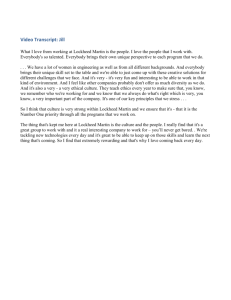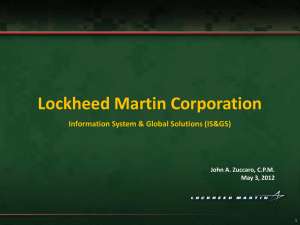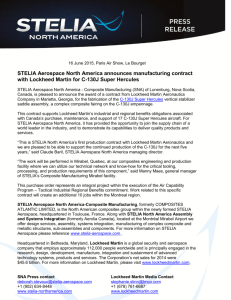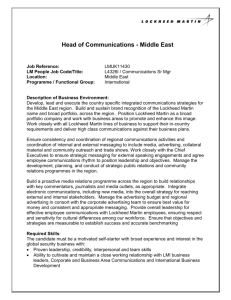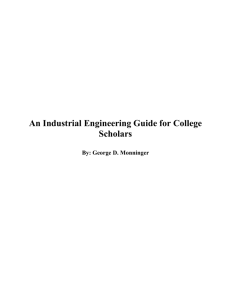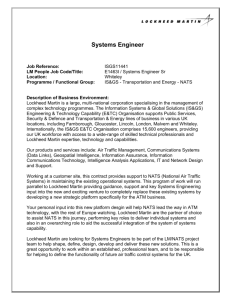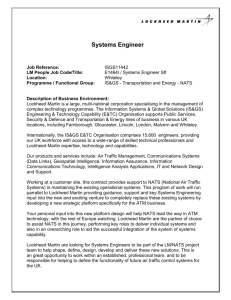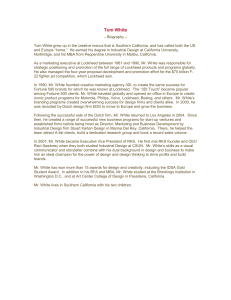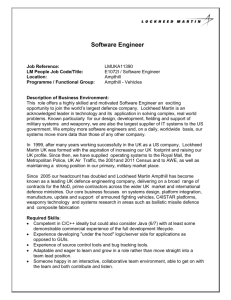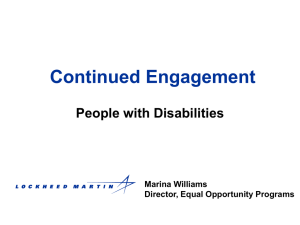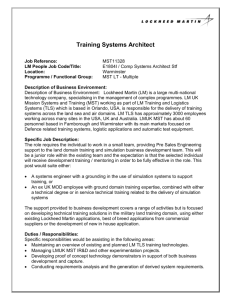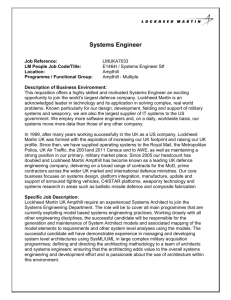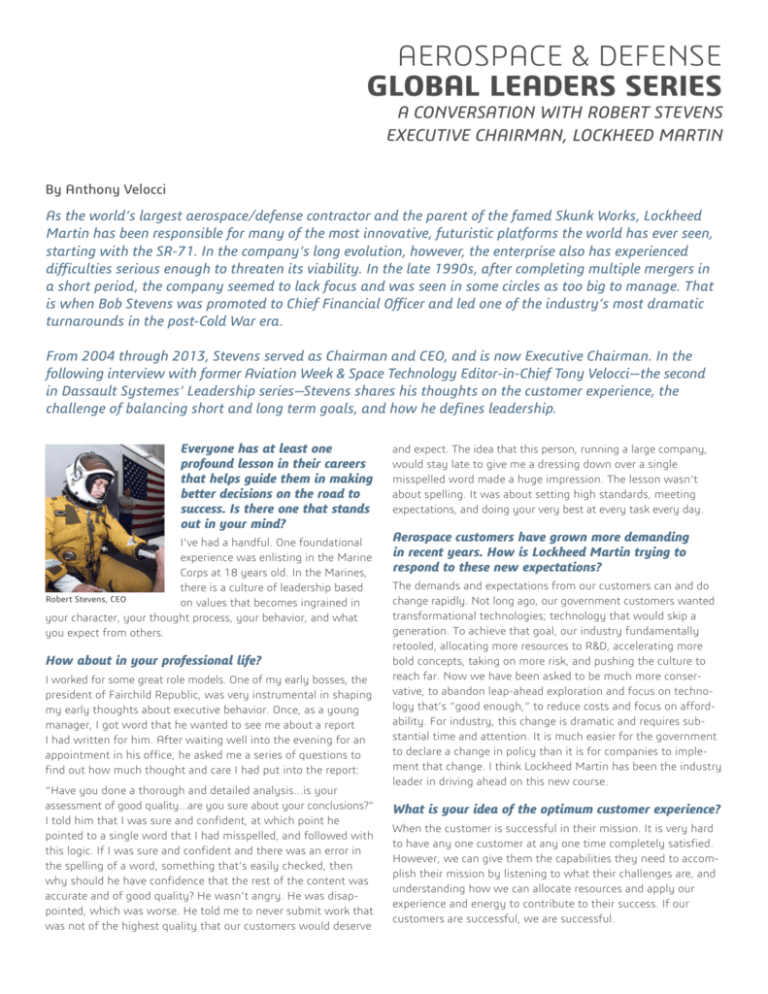
AEROSPACE & DEFENSE
GLOBAL LEADERS SERIES
A CONVERSATION WITH ROBERT STEVENS
EXECUTIVE CHAIRMAN, LOCKHEED MARTIN
By Anthony Velocci
As the world’s largest aerospace/defense contractor and the parent of the famed Skunk Works, Lockheed
Martin has been responsible for many of the most innovative, futuristic platforms the world has ever seen,
starting with the SR-71. In the company’s long evolution, however, the enterprise also has experienced
difficulties serious enough to threaten its viability. In the late 1990s, after completing multiple mergers in
a short period, the company seemed to lack focus and was seen in some circles as too big to manage. That
is when Bob Stevens was promoted to Chief Financial Officer and led one of the industry’s most dramatic
turnarounds in the post-Cold War era.
From 2004 through 2013, Stevens served as Chairman and CEO, and is now Executive Chairman. In the
following interview with former Aviation Week & Space Technology Editor-in-Chief Tony Velocci—the second
in Dassault Systemes’ Leadership series—Stevens shares his thoughts on the customer experience, the
challenge of balancing short and long term goals, and how he defines leadership.
Everyone has at least one
profound lesson in their careers
that helps guide them in making
better decisions on the road to
success. Is there one that stands
out in your mind?
I’ve had a handful. One foundational
experience was enlisting in the Marine
Corps at 18 years old. In the Marines,
there is a culture of leadership based
Robert Stevens, CEO
on values that becomes ingrained in
your character, your thought process, your behavior, and what
you expect from others.
How about in your professional life?
I worked for some great role models. One of my early bosses, the
president of Fairchild Republic, was very instrumental in shaping
my early thoughts about executive behavior. Once, as a young
manager, I got word that he wanted to see me about a report
I had written for him. After waiting well into the evening for an
appointment in his office, he asked me a series of questions to
find out how much thought and care I had put into the report:
“Have you done a thorough and detailed analysis…is your
assessment of good quality...are you sure about your conclusions?”
I told him that I was sure and confident, at which point he
pointed to a single word that I had misspelled, and followed with
this logic. If I was sure and confident and there was an error in
the spelling of a word, something that’s easily checked, then
why should he have confidence that the rest of the content was
accurate and of good quality? He wasn’t angry. He was disappointed, which was worse. He told me to never submit work that
was not of the highest quality that our customers would deserve
and expect. The idea that this person, running a large company,
would stay late to give me a dressing down over a single
misspelled word made a huge impression. The lesson wasn’t
about spelling. It was about setting high standards, meeting
expectations, and doing your very best at every task every day.
Aerospace customers have grown more demanding
in recent years. How is Lockheed Martin trying to
respond to these new expectations?
The demands and expectations from our customers can and do
change rapidly. Not long ago, our government customers wanted
transformational technologies; technology that would skip a
generation. To achieve that goal, our industry fundamentally
retooled, allocating more resources to R&D, accelerating more
bold concepts, taking on more risk, and pushing the culture to
reach far. Now we have been asked to be much more conservative, to abandon leap-ahead exploration and focus on technology that’s “good enough,” to reduce costs and focus on affordability. For industry, this change is dramatic and requires substantial time and attention. It is much easier for the government
to declare a change in policy than it is for companies to implement that change. I think Lockheed Martin has been the industry
leader in driving ahead on this new course.
What is your idea of the optimum customer experience?
When the customer is successful in their mission. It is very hard
to have any one customer at any one time completely satisfied.
However, we can give them the capabilities they need to accomplish their mission by listening to what their challenges are, and
understanding how we can allocate resources and apply our
experience and energy to contribute to their success. If our
customers are successful, we are successful.
What lessons do you think other companies could learn
from the way Lockheed Martin, under your leadership,
approached the challenge of delivering the optimum
customer experience?
We applied exceptionally rigorous discipline and focus to
fundamentals. That may not sound exciting, but if you’re an
aerospace and defense company, you need to have engineering
excellence. You need to have an execution model in design,
development, production, and sustainment, and you need to
continually refine that model. You must consistently deliver
against a set of exceptionally demanding commitments while
setting uncompromisingly high standards.
We spend a lot of time talking about what “perfect” looks like.
Knowing full well that we all have limitations, we strive to achieve
the highest performance possible. When we don’t, we are very
candid with ourselves that anything less than perfect is unacceptable, and we must redouble our effort and move forward.
What is the essential quality or ingredient for success
that underperforming companies seem to overlook?
I don’t know if it’s a single ingredient or an array of ingredients.
At Lockheed Martin, we have a lot of spirited discussions about
the expectations of employees, shareholders and customers, and
about how we should allocate capital. But when we have settled
on an approach, everybody has a playbook and pursues it every
day. We are relentless. That is where an enterprise gets its
maximum operating leverage.
If you want to understand how to deliver a customer experience
at the highest levels, you must have a feel for what that experience should be. You cannot understand your customers when
sitting in your office because you’re too insulated. You must go
to where customers work, see the world through their eyes,
listen more than you talk, and share what you’ve learned with
people who are responsible for product design, development,
production, and sustainment. I got out as often as I could. I have
been catapulted off the deck of the Harry S. Truman (aircraft
carrier) in an F/A-18, flown an AH-64 Apache helicopter at
treetop level at night, ridden to the edge of space in a U-2, and
visited our forward-deployed troops in Afghanistan. That is living
a day in the lives of our customers, and you can’t come away
from those experiences without great admiration for what they
do and an abiding commitment to get our part right. In every
market, customers have a set of needs and interests that define
value in a specific way. It is incumbent upon the leadership of an
enterprise to understand that value and how to enrich it.
Under your leadership, what did Lockheed Martin do to
make sure the company stayed focused on innovation
and new technologies to meet the needs of your
customers?
You can’t cut your way to long-term success, you must invest. If
you adopt a management model that only involves cost cutting,
particularly in R&D, that may work for the first year in terms of
generating better financial performance, but it will not sustain
the business over the long haul. It takes a balance of cutting
costs and driving efficiencies while making sound investments.
During the last five years, we reduced our overhead expenditures
by hundreds of millions of dollars while simultaneously
increasing our investment in R&D.
I’ll give you a specific example. We’re living in a world today
that is the Wild West relative to information technology and
cyber security. You cannot cut investment in these areas and
hope to be a global security provider in the 21st Century. We
needed more investment resources in this domain and the way
we got them was to aggressively attack our cost structure and
make hard choices with respect to resource allocation. That
action allowed us to increase our investment in IR&D by more
than $100 million during a period of business contraction
because that is what the strategic environment required of us.
I am very proud of our leadership team for their willingness to
routinely engage in this practice.
What role, if any, have business practices outside of
A&D influenced what you did to improve the customer
experience?
A lot. For example, we have always built airplanes in relatively
static fixtures where we move the airplane as it is progressively
assembled to a new set of expensive tools. As we looked at the
early demand expectations for the F-35, we looked at the concept
of a moving assembly line and examined whether we could apply
such long-standing concepts from the auto industry to airplane
manufacturing. We visited Ford, got some great ideas, and if you
were to visit our Fort Worth facility, you would see we are using
a moving assembly line for assembling F-35s.
If we can improve quality and lower costs for our customers,
make the work environment safer for our employees, and create
a better product, we will incorporate an idea from wherever we
find it. We may tailor it to our needs, but we will try to draw the
maximum value from that idea. I believe our customers expect
us to do that on their behalf.
Are you at all concerned that the industry is becoming
too risk-averse, given your customers’ changing
expectations and the new operating environment?
I do believe the environment in which the aerospace and defense
industry operates has become more risk-averse, and I do not
believe that this direction is healthy or desirable. Our industry has
taken on some of the most demanding challenges ever envisioned;
the invention of powered flight, the development of rockets and
spacecraft supporting exploration of the universe, advancing
precision electronics and information systems. Through the
application of advanced science, we create things that have not
existed before and we do this in public. Fundamental scientific
methodology requires a degree of conjecture and experimentation
when seeking knowledge and exploring the unknown, where
sometimes a hypothesis is confirmed and sometimes it is not,
but with each effort, much is learned, and the learning valuable.
In today’s climate, however, where any outcome that is not
immediately perfect draws a huge level of public criticism, there
is a strong disincentive for people and institutions to take the
kinds of risks that are necessary to drive discovery. Let me give
you an example:
Early in my tenure at Lockheed Martin, I had the good fortune of
reading some of Kelly Johnson’s notebooks. [Kelly Johnson was
the father of the legendary Skunk Works, which was responsible
for some of the most visionary, aeronautical technology in the
history of aviation.] In one entry, he made notations about an
airplane’s high-speed taxi test. The aircraft took off prematurely
due to uncertain wind gusts and its lift characteristics, then
“porpoised” in flight. A hard landing compressed the gear and
the brakes caught fire. Kelly appended in the margin, “Learned
a great deal. Great test.” In today’s environment, that test would
be a highly publicized failure and the program might well have
been canceled.
Physics haven’t changed. Scientific methodology hasn’t changed.
We don’t know everything about everything. A development
program is a program of exploration. That’s why we test. What’s
changed is the attitude and understanding about learning and
risk. We have diminished our tolerance for things that do not go
perfectly well, and amplified our desire to criticize. All of this is
driving much less tolerance for risk, and this is not good for the
future of exploration.
What is the definition of leadership?
Leadership is the ability to prepare an organization for change
and direct it through uncertainty. Leaders understand the essence
of the enterprise, what it believes in, and why. They assess the
world in which we live and what it’s apt to look like in the future.
They then bring their perspective forward, lay in the resources,
prepare the workforce, set the standards, invest in technologies
and people, and inspire and motivate others so the enterprise
will prosper and contribute to a very defined set of goals in the
future. The leaders at Lockheed Martin have been able to do
that very, very well because we fully immersed ourselves in
the process of leadership development.
The Aerospace & Defense Leadership Series is sponsored by Dassault Systèmes, the 3DEXPERIENCE® Company.
Learn more: www.3ds.com/aerospace-defense.
© Dassault Systèmes 2014, all rights reserved. 3DEXPERIENCE is a registered trademark of Dassault Systèmes.
A 24-year veteran of Aviation Week, Tony Velocci
is former editor-in-chief of Aviation Week & Space
Technology magazine as well as editorial director
of Aviation Week Group.

